Science fact: Sci-fi inventions that became reality
- Published

Light speed travel and tractor beams - researchers have toyed with both
The story of a 14-year-old girl who won a landmark legal battle to be preserved cryogenically has many people wondering how such technology actually works - for many of us, it seems like something straight out of science fiction.
But sci-fi has a long history of becoming science fact, as outlandish creations inspire real research.
Remarkable realities
Tractor beams
In Star Wars, the unfortunate heroes are caught in a "tractor beam" that freezes their ship and pulls them towards the enemy. Star Trek has a similar weapon.
An Australian university can do the same thing - although its experiments with lasers could only manage to move a tiny object (one fifth of a millimetre) along about 20cm.

A grid of programmable speakers creates invisible "hologram" shapes from ultrasound waves
British researchers, meanwhile, have been experimenting with sound waves to shift objects through the air - and can just about manage objects the size of a pea at about 40cm away.
The moon landing
In 1865, Jules Verne published the outlandish novel From the Earth to the Moon, in which three Americans are fired into space in a gun. In his story, the three men launch a lunar vessel called Columbiad, weighing a little under 20,000 lbs, at a cost of $5.5m.
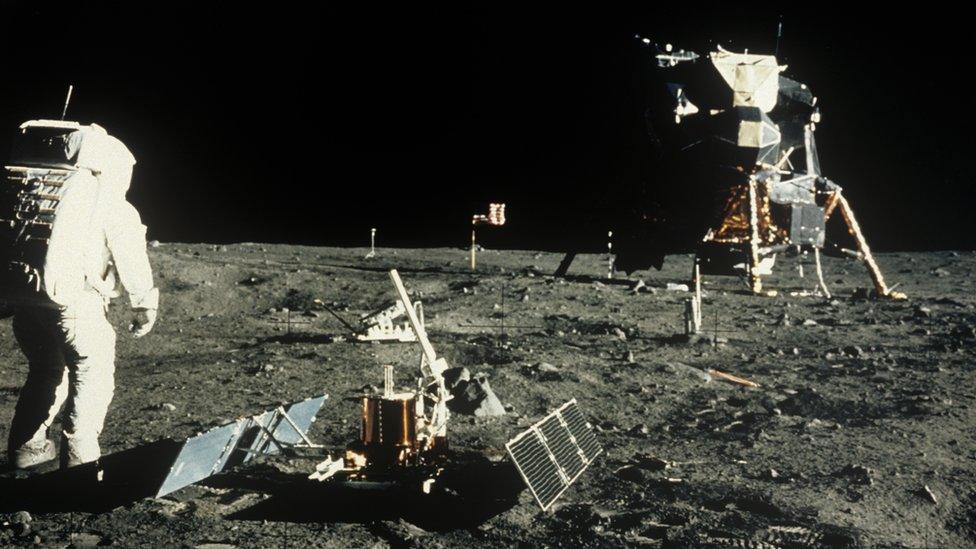
Buzz Aldrin pictured next to the lunar lander after is separated from Columbia
A century later, America did send three men to the moon - in the command module Columbia, which weighed 26,300 lbs, at a cost of $16bn.
To cap it all off, Verne's estimate of $5.5m was equivalent to about $13bn in 1969.
No more needles - the hypospray
In the world of Star Trek (which also predicted flip phones), any ill character is almost miraculously healed by an "injection" from a hypospray - a device with no needles that delivers the cure painlessly, through the skin.
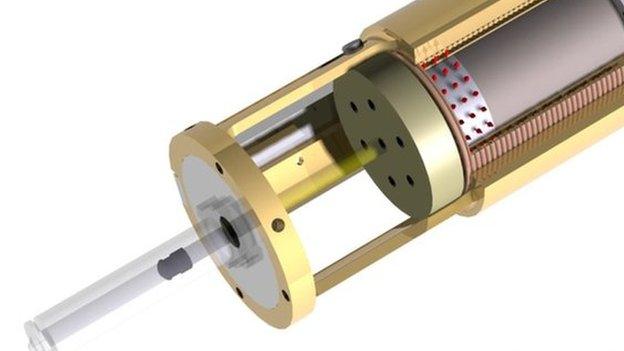
No more needles? MIT hopes so
That is a jet injector, and although famous from the TV show, actually predates it. Aaron Ismach invented the jet injector in 1960, six years before Star Trek. It was used for mass vaccinations - especially in the military - since it could be used over and over again. But that brought contamination risks, so it has fallen out of use.
However, the idea hasn't gone away. In 2012, MIT released an updated design, external for the "hypospray" which can be programmed for many uses, and inject drugs at the speed of sound, which they hope will eventually eliminate the need for needles.
Energy weapons
We're a long way from laser pistols, but a modern energy weapon is the US military's "active denial system", used for crowd control. The non-lethal weapon works like a microwave oven, and causes extreme discomfort as it heats the target's body underneath the skin - and causing the target to flee.

Thomas A Swift's Electric Rifle, envisioned in 1911, and reborn as the Taser
And the Taser personal defence weapon is actually an acronym for Thomas A Swift's Electric Rifle.
Nasa researcher Jack Cover, who created the device, named it after a 1911 book he read as a child, in which the eponymous hero invents a gun that fires bolts of lightning.
Wells and Asimov
Most remarkable of all, perhaps, is the eerie accuracy of a handful of science fiction writers in the 20th century.
HG Wells predicted automatic sliding doors in 1899, and the atomic bomb in his novel The World Set Free, written in 1913 and published the following year.

Atomic bombs were predicted before World War One - but would not be used until the end of the second
Isaac Asimov, however, made some startlingly accurate predictions about 2014, in an essay to mark the 1964 World's Fair,
They included global video calling, robots that would "neither be common nor very good in 2014", flatscreen TVs and early 3D and self-driving cars.
Impractical impossibilities
Such predictions suggest anything is possible. But there are still plenty of limits on what we can do. Some research, while reported on with incredible headlines, simply hasn't reached any practical application yet.
Invisibility 'cloak'
Whether you're a Harry Potter fan or a space traveller, "cloaking" is often used to refer to invisibility, bending light around an object to make it disappear.

The Rochester Cloak is one optical trick to make objects "vanish"
This can actually be done for small objects - if you want to arrange a set of lenses in a precise arrangement, using the Rochester Cloak technique, it can be reproduced at home. But with its strict set up, it's just an optical trick.
Other "cloaking" attempts have been able to hide objects from microwaves or radar, but there's nothing yet that can fool the human eye in practical scenarios.
Power armour
From Iron Man to future dystopia, powered armour for soldiers has always been a staple in sci-fi. The US military is among those with an eye on the idea.
TALOS - that's a Tactical Assault Light Operator Suit - has often been described as an "Iron Man suit", but is far less exotic than the superhero's attire.
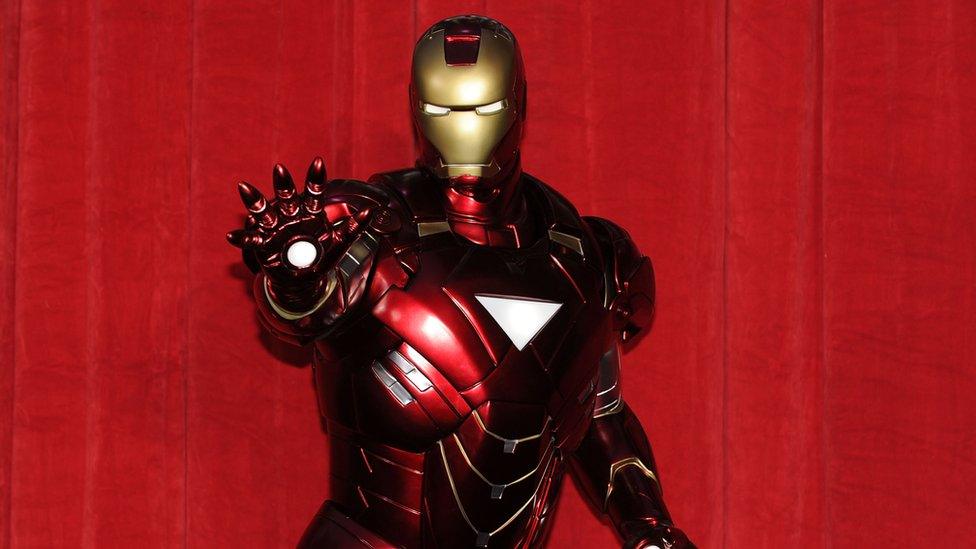
The fictional Iron Man suit can fly, is nearly indestructible and fires concussive energy weapons
Instead, the US Army hoped to create a "smart" bodysuit, which monitors soldiers' vital signs, with a powered exoskeleton to increase strength.
The project is rumoured to use liquid armour which solidifies when hit by bullets - but very little is known about its progress.
Teleporters
The "transporter", a staple of sci-fi, is probably impossible. But that doesn't stop it making headlines.
In a process called quantum entanglement, a change made to one particle in lab conditions can affect another one, some distance away. It's a way to send information from one place to another, without it travelling in the space between, hence "quantum teleportation".
But the particles involved - qubits - are information only, and there's no evidence that it can be used for atoms, molecules and certainly not people - but it could lead to a futuristic internet.
Warp drive theory
In Star Trek and many other films and television shows, "warp drive" is a way to travel faster than light (which should be impossible) by bending space around a spacecraft.
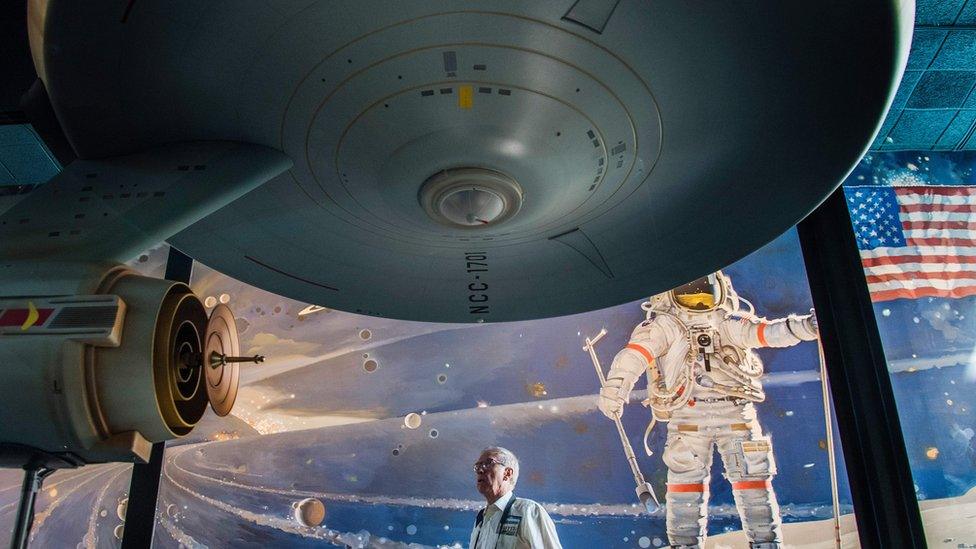
A model of the starship Enterprise - which coined the idea of warp drive - hangs in the Smithsonian museum
The closest we have is called an "Alcubierre drive", after the mathematician who proposed it.
The idea is to shrink space in front of the ship and expand space behind it - so the ship itself never has to travel at light speed.
But it has so many practical problems it may never actually exist, and Nasa generally considers it impossible - despite the occasional piece of research, external on the topic.
- Published18 November 2016
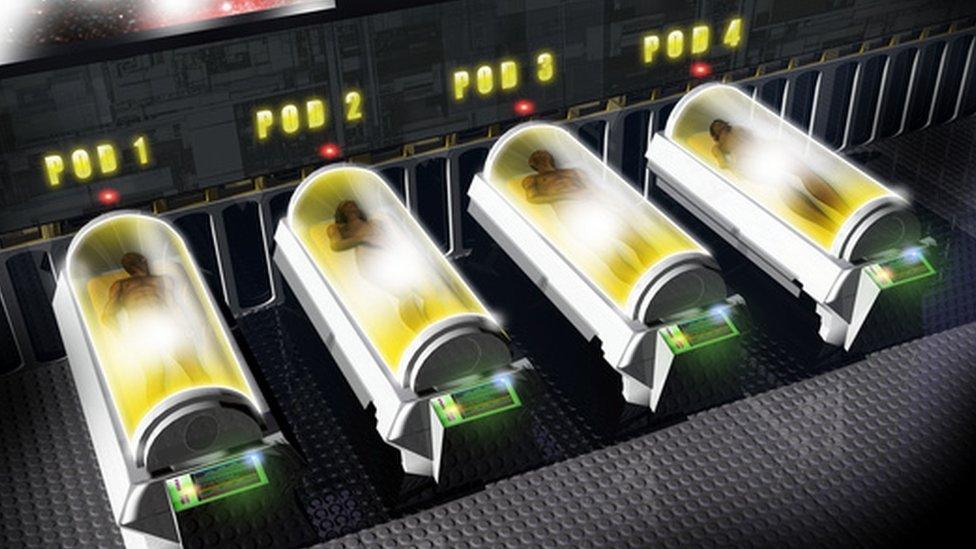
- Published18 November 2016

- Published18 November 2016
